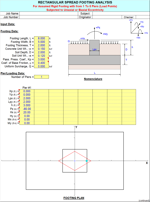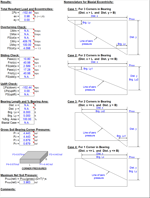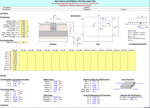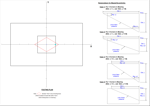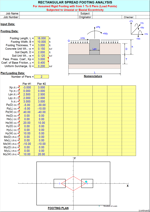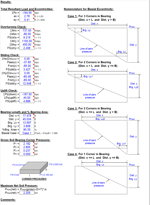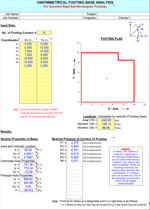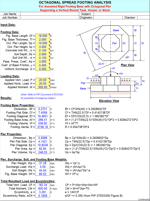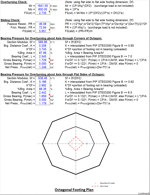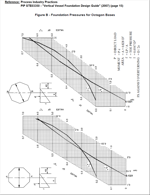FOOTINGS.xlsx

Description
<p>Civil engineers design footings to provide a stable and strong foundation for various types of structures, such as buildings, bridges, and towers. Footings distribute the load from the structure to the soil or rock beneath, ensuring that the foundation remains stable and the structure does not experience excessive settlement or differential settlement. The design process typically involves the following steps:</p>
<ol>
<li>
<p>Site investigation: Civil engineers conduct a thorough geotechnical investigation of the site to determine the soil and rock properties, groundwater conditions, and any potential hazards. This information is crucial for selecting the appropriate type of footing and designing its dimensions.</p>
</li>
<li>
<p>Determine loads: Engineers calculate the loads that the footing must support, including dead loads (weight of the structure), live loads (occupants and contents), and other loads such as wind, snow, and seismic forces, depending on the location and the type of structure.</p>
</li>
<li>
<p>Select footing type: Based on the site conditions and the structure's requirements, engineers choose an appropriate type of footing. Common footing types include isolated or spread footings, combined footings, strip footings, mat or raft foundations, and pile foundations.</p>
</li>
<li>
<p>Bearing capacity analysis: Engineers analyze the soil or rock's bearing capacity to ensure that the footing can safely support the applied loads without excessive settlement or failure. They use geotechnical data from site investigations and apply various methods, such as Terzaghi's bearing capacity theory or empirical correlations, to estimate the bearing capacity.</p>
</li>
<li>
<p>Settlement analysis: Settlement analysis is performed to estimate the expected total and differential settlement of the footing. Engineers ensure that the calculated settlement values are within acceptable limits to prevent structural damage or functional issues.</p>
</li>
<li>
<p>Size and reinforcement: Based on the bearing capacity, settlement analysis, and load calculations, engineers design the footing's dimensions (width, length, and depth) and determine the required reinforcement, such as steel bars or mesh, to provide adequate strength and stability.</p>
</li>
<li>
<p>Construction considerations: Engineers also consider construction techniques, materials, and quality control measures, ensuring that the footing is built according to the design specifications and performs as intended.</p>
</li>
<li>
<p>Final design and documentation: The completed footing design is documented in detailed drawings and specifications, which serve as a guide for the construction team and for obtaining necessary permits and approvals.</p>
</li>
</ol>Program Description:
'FOOTINGS' is a spreadsheet program written in MS-Excel for the purpose of analysis of rigid rectangular spread footings with up to 16 total piers, and for either uniaxial or biaxial resultant eccentricities. Overturning sliding, and uplift stability checks are made when applicable, and resulting gross soil bearing pressures at
the four (4) corners of the footing are calculated. The maximum net soil bearing pressure is also determined. There are also separate worksheets for the analysis of unsymetrical footings and octagonal footings.
This program is a workbook consisting of eight (8) worksheets, described as follows:
Worksheet Name - Description
Doc - Documentation sheet
Footing (8 net pier loads) - Individual rectangular spread footing analysis (with up to 8 net pier loadings)
Footing (16 net pier loads) - Individual rectangular spread footing analysis (with up to 16 net pier loadings)
Footing (breakdown of loads) - Individual rectangular spread footing analysis (with breakdown of loadings)
Unsymmetrical Footing Base - Unsymmetrical rigid footing base bearing pressure analysis
Octagonal Footing - Octagonal spread footing analysis
Footings (Table) - Multiple rectangular spread footings analysis and design (table format)
Footings (Pier Table) - Multiple rectangular spread footings - pier analysis (table format)
Program Assumptions and Limitations:
- This program assumes that the spread footing is in fact 'rigid', so that the bearing pressure is distributed linearly on a homogeneous soil. (Note: the actual footing is generally not 'rigid', nor is the pressure beneath it distributed linearly. However, it has been found that solutions using the assumed 'rigid' concept are adequate and generally result in a conservative design.)
- This program assumes an orthogonal X-Y-Z coordinate system with the origin located at the centroid of the footing in plan (footprint). 'Right-Hand-Rule' sign convention is used for input of all pier coordinates as well as for all applied forces and moments at piers.
- This program can handle from 1 up to either eight (8) or sixteen (16) total piers located anywhere on the base of the footing. Piers can be numbered in any desired order.
- This program does not check the actual calculated soil bearing pressure against a given allowable soil pressure. This is done so that the extent of acceptable overstress is left up to the judgment of the user. However, in all cases this must be checked by the user.
- This program does not use a specified permissible value for the factor of safety against overturning. However, a minimum value of 1.5 to 2.0 is suggested, based upon the particular conditions. (A 'Footing is unstable!' error message will be displayed if the factor of safety against overturning is 1.0. Then the user must revise the footing dimensions or other parameters.)
- This program does not use a specified permissible value for the factor of safety against uplift. However, a minimum value of 1.2 to 1.5 is suggested, based upon the particular conditions and the extent of footing confinement. (A 'Footing is unstable!' error message will be displayed if the factor of safety against uplift is 1.0. Then the user must revise the footing dimensions or other parameters.)
- The 'Footing (net pier loads)' worksheets deal with net applied loadings at the piers. That is, there is no allowance for individual breakdown of dead, live, and wind (or seismic) loadings. This worksheet should be specifically used in any of the following conditions:
- When the individual breakdown of loadings is not known or is not critical
- When there are little or no uplift or overturning forces and moments due to wind (or seismic)
- When the factor of safety against uplift or overturning due to wind (or seismic) is NOT critical
- When there are overturning forces or moments due to only gravity (dead or live) loadings
- The 'Footing (net pier loads)' worksheets consider all net applied moments and horizontal loads as forces causing overturning. However, a net uplift load is considered as a force causing overturning only when there is an applicable resultant eccentricity in the direction of overturning. For a net uplift pier load, the 'excess' pier weight (pier weight less soil weight) is subtracted from the net uplift load at the pier location.
- The 'Footing (breakdown of loads)' worksheet allows for individual breakdown of dead, live, and wind (or seismic) loadings. This worksheet should be specifically used in any of the following conditions:
- When the individual breakdown of loadings is known or is critical
- When there are uplift or overturning forces and moments due to wind (or seismic)
- When the factor of safety against uplift or overturning due to wind (or seismic) is critical
- When there are no overturning forces or moments due to only gravity (dead or live) loadings
- The 'Footing (breakdown of loads)' worksheet considers only applied wind (or seismic) shears, uplifts, and moments as forces causing overturning. Any wind (or seismic) loads which act in opposite direction to sense of overturning are considered as forces which reduce the total overturning. Only applied pier dead (not live) loadings are considered as forces resisting overturning. Any dead loadings which act in opposite direction to sense of resisting overturning are considered as forces which reduce the total resistance to overturning.
- This program includes the uniform live load surcharge in the calculation of the soil bearing pressures. The uniform live load surcharge is not included in the calculation of 'resisting' moment for overturning check, nor in the calculations for uplift check. The uniform live load surcharge is assumed to act over the entire footing plan area.
- This program will calculate the soil bearing pressures at the corners of the footing for all cases of resultant eccentricity, both uniaxial and biaxial. The corners of the footing are always designated in the footing plan proceeding counterclockwise from the lower right-hand corner as follows:
(3) =upper left-hand corner (2) =upper right-hand corner
(4) =lower left-hand corner (1) =lower right-hand corner
- Reference used in this program for footing with cases of biaxial resultant eccentricity is:
'Analytical Approach to Biaxial Eccentricity' - by Eli Czerniak
Journal of the Structural Division, Proceedings of the ASCE, ST4 (1962), ST3 (1963)
- Another more recent reference for footing with cases of biaxial resultant eccentricity is:
'Bearing Pressures for Rectangular Footings with Biaxial Uplift' - by Kenneth E. Wilson
Journal of Bridge Engineering - Feb. 1997
- The 'Unsymmetrical Footing Base' worksheet can aid the user with analysis of maximum soil pressure for situations where a non-rectangular shaped rigid footing base has to be used.
- The 'Octagonal Footing' worksheet can aid the user with analysis of the soil pressures and stability checks for octagonal shaped rigid footing with an octagonal shaped pier.
- The 'Footings (Table)' and 'Footings (Pier Table)' worksheets enable the user to analyze/design virtually any number of individual footings or footing load combinations. The footings must have only one concentric pier. The footings may be subjected to biaxial eccentricities as long as 100% bearing is maintained. If one or more corners become unloaded from biaxial eccentricities, then the error message, 'Resize!' will be displayed. Refer to those two worksheets for list of specific assumptions used in each. The column loads and footing/pier dimensions input in rows 'A' through 'Q' of the 'Footings (Table)' worksheet may be copied and pasted (via 'Paste Special, Values' command) into the same position in the 'Footings (Pier Table)' worksheet. The entire row of calculation cells can then be copied and pasted down the page to match the number of rows of input in each of the two table format worksheets.
- The 'Footings (Table)' and 'Footings (Pier Table)' worksheets enable the user to select either the ACI 318-99, 318-02, 318-05, 318-08, or 318-11 Code to perform the reinforced concrete analysis/design for one-way (beam-type) shear, two-way (punching) shear, and flexural reinforcing requirements.
- In the 'Footings (Table)' worksheet, the program assumes a 'tension controlled' section and uses f = 0.90 to determine required reinforcing. This is appropriate for the ACI 318-99 Code with applicable load factors. However, for either the ACI 318-02, 318-05, 318-08, or 318-11 Codes, f must be determined based on actual reinforcing used. If f 0.90 then the footing thickness will need to be increased until the calculated value of f is = 0.90 in order to use reinforcing results determined from this program.
- In the 'Footings (Pier Table)' worksheet, for pure flexure (no axial load) the program determines the strain in the tension reinforcing and then the capacity reduction factor f = 0.90.
- This program contains numerous “comment boxes” which contain a wide variety of information including explanations of input or output items, equations used, data tables, etc. (Note: presence of a “comment box” is denoted by a “red triangle” in the upper right-hand corner of a cell. Merely move the mouse pointer to the desired cell to view the contents of that particular 'comment box'.)
Calculation Preview
Full download access to any calculation is available to users with a paid or awarded subscription (XLC Pro).
Subscriptions are free to contributors to the site, alternatively they can be purchased.
Click here for information on subscriptions.

